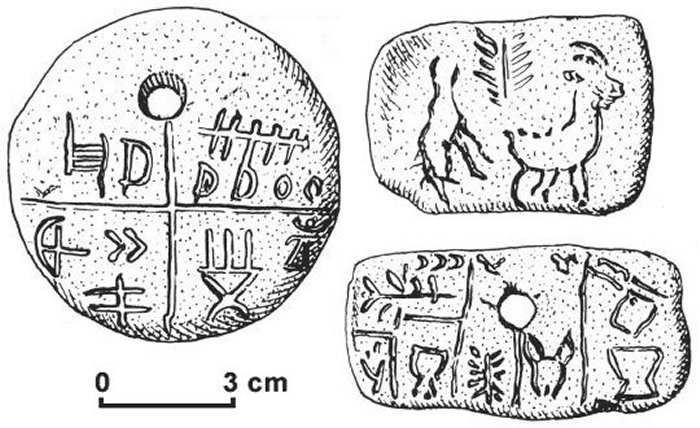Controversial Tartaria Tablets: The First Writing System In The World?
A. Sutherland AncientPages.com - The so-called "Tartaria Tablets" were examined by a number of scientists from all across the world and isotope carbon 14 dating revealed they were created at least 6,500 years ago.
The tablets covered with pictographic writing are extraordinary because they raise the possibility that writing in the Danube basin predated the earliest Sumerian cuneiform and Egyptian hieroglyphics.
Tartaria Tablets. source
In 1963, Nicolae Vlassa wrote "about several inscribed plaques discovered in an early Vinca grave at Tartaria, near Cluj. He assumed that the plaques (wrongly called "tablets") were Mesopotamian imports. In 1968, M. S. F (Sinclair) Hood considered the Tartaria plaques "an uncomprehending hending imitation of more civilized people's written records."
Vlassa "failed to recognize, however, that Old European writing, such as that on the Vinca cultic objects, predated Mesopotamian script by several thousand years, even though several good radiocarbon chronologies existed for the Vinca culture in the late 1960s..." 1
The discovery caused great interest and controversy in the scientific community because this suggests that the Tartaria tablets represent the first writing in the world, which we know of. The tablets, which are 1,000 years older than the Mesopotamian writings contain signs that have remained undeciphered to this day.
Nicolae Vlassa, an archaeologist at the National Museum of Transylvanian History, Cluj-Napoca who was the original discoverer of the three tablets also unearthed 26 clay and stone figurines and a shell bracelet, accompanied by the burnt, broken, and disarticulated bones of an adult male.
The place of discovery was a Neolithic site in the village of Tartaria (about 30 km (19 mi) from Alba Iulia), in Romania. Two of the tablets are rectangular and the third is round. The Tartaria tablets are small and two of them have holes drilled through them.
Were they used as a kind of amulets?
The dating of the tablets is difficult as they cannot be carbon-dated and the stratigraphy is uncertain. A few scientists suppose that they may date to around 5300 BC.

One thing is sure: the writing found on the Tartaria Tablets is the first writing in the world, which we know of. Unfortunately, the signs have remained indecipherable until this day. Image source
The tablets bear incised symbols and have been the subject of considerable controversy among archaeologists, some of whom claimed in the past that the symbols represent the earliest known form of writing in the world. The symbols are thought to be Vinca symbols, although some scholars have considered them to be Sumerian
What is common for all three tablets is that they are inscribed only on one face.
The rectangular tablet depicts a horned animal, an unclear figure, and a vegetal motif, a branch or tree. The others have a variety of mainly abstract symbols. The purpose of the burial is unclear, but it has been suggested that the body was, if not that of a shaman or spirit-medium, that of a local most respected wise person.
Interestingly, a 5,500-year-old clay pot with similar symbols was discovered in Bulgaria.
Naturally, there have been a lot of suggestions about the meaning of the symbols. Scholars have put forward a number of theories, but the truth is that there is still no-one that can explain the enigmatic signs inscribed on the Tartaria tablets.
There are also some scientists who think the Tartaria tablets are in fact the world's oldest writing system that we have encountered.
The meaning of the symbols is unknown, and their nature has been the subject of much debate, but their existence clearly suggests that the Danube civilization invented a writing system long before the Sumerians.
It is a controversial claim, but evidence indicates that this was a very likely event.
For now, the true nature and meaning of the Tartaria tablets remain an unexplained mystery, but there is much debate, many theories, and suggestions.
Written by – A. Sutherland - AncientPages.com Senior Staff Writer
Copyright © AncientPages.com All rights reserved. This material may not be published, broadcast, rewritten or redistributed in whole or part without the express written permission of AncientPages.com
Expand for referencesGimbutas M. The Living Goddesses
More From Ancient Pages
-
 What Was The Medieval Shame Flute?
Ancient History Facts | Jan 27, 2020
What Was The Medieval Shame Flute?
Ancient History Facts | Jan 27, 2020 -
 Hesperides – Greek Nymphs Who Guarded Fabled Garden With Divine Apples Of Immortality
Featured Stories | Jun 4, 2020
Hesperides – Greek Nymphs Who Guarded Fabled Garden With Divine Apples Of Immortality
Featured Stories | Jun 4, 2020 -
 Why Was Grette The Strong, Icelandic Poet And Warrior Afraid Of Darkness?
Featured Stories | Sep 30, 2023
Why Was Grette The Strong, Icelandic Poet And Warrior Afraid Of Darkness?
Featured Stories | Sep 30, 2023 -
 Gigantic Engravings Of A Giraffe Created Long Before Egypt As We Know It Existed
Ancient Mysteries | Jan 14, 2015
Gigantic Engravings Of A Giraffe Created Long Before Egypt As We Know It Existed
Ancient Mysteries | Jan 14, 2015 -
 Challenging Prehistoric Gender Roles – Women Were Hunters Too – Not Just Men
Archaeology | Oct 21, 2023
Challenging Prehistoric Gender Roles – Women Were Hunters Too – Not Just Men
Archaeology | Oct 21, 2023 -
 New AI Technique Will Help To Decode Long Lost Languages Of Ancient World
News | Oct 21, 2020
New AI Technique Will Help To Decode Long Lost Languages Of Ancient World
News | Oct 21, 2020 -
 2,000-years-old tomb found in S. China
Archaeology | Apr 6, 2016
2,000-years-old tomb found in S. China
Archaeology | Apr 6, 2016 -
 Akrotiri Of Thera: Sophisticated City In The Greek Cyclades Devastated By Volcanic Eruption
Civilizations | Jul 6, 2016
Akrotiri Of Thera: Sophisticated City In The Greek Cyclades Devastated By Volcanic Eruption
Civilizations | Jul 6, 2016 -
 Proof That Neanderthals Ate Crabs 90,000 Years Ago Is Another ‘Nail In The Coffin’ For Primitive Cave Dweller Stereotypes
Archaeology | Feb 7, 2023
Proof That Neanderthals Ate Crabs 90,000 Years Ago Is Another ‘Nail In The Coffin’ For Primitive Cave Dweller Stereotypes
Archaeology | Feb 7, 2023 -
 Mysterious La Berta – ‘Petrified’ Stone Head And The Curse Of Cecco d’Ascoli Who Was Burned At The Stake
Featured Stories | Jul 29, 2019
Mysterious La Berta – ‘Petrified’ Stone Head And The Curse Of Cecco d’Ascoli Who Was Burned At The Stake
Featured Stories | Jul 29, 2019 -
 Abydos: One Of The Most Important Cities Of Ancient Egypt
Featured Stories | Jul 15, 2016
Abydos: One Of The Most Important Cities Of Ancient Egypt
Featured Stories | Jul 15, 2016 -
 The Red Dragon Of Wales – Ancient Symbol Dating Back To Roman Times
Ancient Symbols | Jan 3, 2018
The Red Dragon Of Wales – Ancient Symbol Dating Back To Roman Times
Ancient Symbols | Jan 3, 2018 -
 On This Day In History: Black Death Arrived In Britain – On June 24, 1348
News | Jun 24, 2016
On This Day In History: Black Death Arrived In Britain – On June 24, 1348
News | Jun 24, 2016 -
 Why The Discovery Of Cleopatra’s Tomb Would Rewrite History
Featured Stories | Nov 16, 2022
Why The Discovery Of Cleopatra’s Tomb Would Rewrite History
Featured Stories | Nov 16, 2022 -
 Yokai Kitsune: Charming And Cunning Liar With Double Nature In Japanese Folklore
Featured Stories | May 22, 2020
Yokai Kitsune: Charming And Cunning Liar With Double Nature In Japanese Folklore
Featured Stories | May 22, 2020 -
 Mjölnir: Thor’s Terrible Axe-Hammer And Its Magical Powers In Norse Mythology
Featured Stories | Apr 20, 2017
Mjölnir: Thor’s Terrible Axe-Hammer And Its Magical Powers In Norse Mythology
Featured Stories | Apr 20, 2017 -
 Enigmatic Nok Culture: A Sub-Saharan Archaeological Puzzle
Civilizations | Mar 7, 2020
Enigmatic Nok Culture: A Sub-Saharan Archaeological Puzzle
Civilizations | Mar 7, 2020 -
 Sanctuary Of Amarysia Artemis, Amarynthos – New Valuable Finds By Greek-Swiss Team
Archaeology | Sep 26, 2022
Sanctuary Of Amarysia Artemis, Amarynthos – New Valuable Finds By Greek-Swiss Team
Archaeology | Sep 26, 2022 -
 Unique Canterbury Roll – Ancient Manuscript Reveals Its Secrets About History Of England
Archaeology | Jan 5, 2018
Unique Canterbury Roll – Ancient Manuscript Reveals Its Secrets About History Of England
Archaeology | Jan 5, 2018 -
 Biblical Prophet Jeremiah Whose Prophecies Disappointed People
Biblical Mysteries | Jan 30, 2019
Biblical Prophet Jeremiah Whose Prophecies Disappointed People
Biblical Mysteries | Jan 30, 2019

